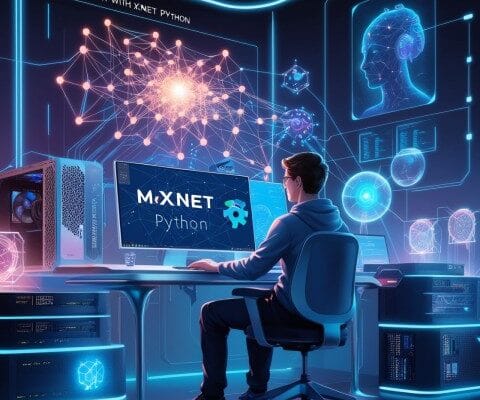MXNet Python: A Comprehensive Guide to Understanding and Using the Deep Learning Framework
MXNet Python is a powerful and flexible deep learning framework. Designed with scalability and efficiency in mind, it is widely used for machine learning tasks such as image recognition, natural language processing, and recommendation systems. This article answers the question, “What is MXNet Python?”, in simple and easy-to-understand language. We will focus on its features, advantages, and practical uses. Whether you are a beginner or a seasoned AI professional, this guide will help you navigate the world of MXNet Python effectively.
What is MXNet Python?
MXNet, short for Apache MXNet, is an open-source deep learning library. It supports multiple programming languages, including Python, R, Scala, and Julia. The Python version, referred to as MXNet Python, is one of the most widely used due to Python’s popularity in the data science and AI community.
MXNet Python allows developers to build, train, and deploy deep learning models efficiently. Key features include:
- Support for both symbolic and imperative programming, providing flexibility for various use cases.
- Optimized performance with GPU and CPU integration.
- Scalability for distributed computing across multiple GPUs and servers.
Why Choose MXNet for Deep Learning?
There are several reasons why MXNet Python is a great choice for deep learning:
- High Performance: MXNet Python is designed to maximize computational speed and efficiency, especially for tasks requiring large datasets.
- Flexibility: With both low-level and high-level APIs, MXNet Python caters to beginners and experts alike.
- Language Compatibility: While this guide focuses on Python, MXNet also supports other languages, making it a versatile framework.
- Scalability: MXNet Python can scale seamlessly for distributed computing, making it ideal for large-scale AI applications.
- Strong Backing: MXNet is an Apache Software Foundation project and is supported by companies like Amazon Web Services (AWS), ensuring its reliability and longevity.
Features of MXNet Python
a) Dynamic and Static Computation Graphs
One of the most notable features of MXNet Python is its support for both dynamic graphs and static graphs.
- Dynamic Graphs: Allow on-the-fly changes during model development, making it easier to debug and experiment.
- Static Graphs: Provide optimized performance and are well-suited for deployment.
b) GPU and CPU Support
MXNet Python leverages GPUs and CPUs efficiently for faster model training and inference. Its ability to handle hardware acceleration ensures high-speed computations.
c) Distributed Training
With built-in support for distributed computing, MXNet Python can train models across multiple devices or even across servers.
d) Memory Optimization
MXNet Python uses techniques like lazy evaluation and memory sharing to optimize memory usage, making it ideal for resource-constrained environments.
e) Gluon API
The Gluon API simplifies deep learning by providing pre-defined models, easy-to-use layers, and tools for model training and evaluation. This makes MXNet Python beginner-friendly while retaining advanced capabilities for experienced users.
MXNet Python is used in various fields, including:
- Image Processing: Object detection, image classification, and facial recognition.
- Natural Language Processing (NLP): Sentiment analysis, text generation, and translation tasks.
- Recommendation Systems: Powering personalized product and content recommendations.
- Autonomous Systems: Enhancing self-driving cars, drones, and robotics.
- Healthcare: Diagnosing diseases using medical imaging data.
Advantages of MXNet
- Efficiency: Optimized for speed and memory usage, MXNet Python is excellent for performance-critical applications.
- Scalability: The ability to train models on multiple GPUs or machines makes MXNet Python suitable for large-scale projects.
- Flexibility: Support for both symbolic and imperative programming provides developers with versatility.
- Beginner-Friendly: The Gluon API simplifies model building and training.
Challenges of MXNet Python
While MXNet Python is a robust framework, it does have some limitations:
- Smaller Community: Compared to TensorFlow and PyTorch, MXNet has fewer tutorials and community resources.
- Steeper Learning Curve: Some advanced features may be difficult for beginners to grasp.
- Dependency on Apache Projects: MXNet Python relies on the Apache ecosystem, which may impact update cycles.
MXNet Python vs. Other Frameworks
Here’s how MXNet Python compares to popular alternatives like TensorFlow and PyTorch:
| Feature | MXNet Python | TensorFlow | PyTorch |
|---|---|---|---|
| Ease of Use | Moderate | Moderate | High |
| Performance | High | High | Moderate |
| Dynamic Graphs | Fully Supported | Partially Supported | Fully Supported |
| Community Support | Moderate | High | High |
Conclusion: Why Learn MXNet Python?
MXNet Python is a versatile and efficient framework that balances performance and usability. Its support for dynamic and static computation graphs, distributed computing, and GPU acceleration makes it ideal for both research and production use.
While frameworks like TensorFlow and PyTorch have gained more popularity, MXNet Python remains a strong contender for deep learning projects. By mastering its features and capabilities, you can leverage MXNet Python to build scalable, high-performance machine learning solutions.
Whether you are new to deep learning or an experienced developer, exploring MXNet Python is a step toward unlocking the potential of AI technologies.



